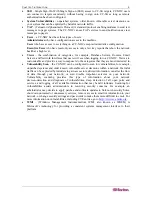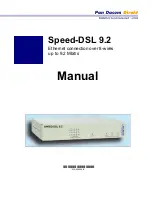
C
HAPTER
1:
INTRODUCTION
3
•
Vulnerability Scanning
•
Event Viewing and Searching
•
Performance Monitoring per category or device
•
Integration with CC-SG where CC-SG is notified of events within the subscribed discovery
range.
•
Scheduled Outages
•
User, Views, and Category Configuration
•
License Upload
•
Event, Outage Notification
•
Asset Management
•
Reports (Outage, Availability, Inventory, Delta Inventory, Vulnerability, Security, SNMP)
•
Tools – Network Tools (ping host, port test, trace route to host, profile route to host)
•
Tools – Admin Tools (export & download configuration files, download log files, check disk
utilization, send incident report, generate diagnostics file)
•
Advanced Admin - Support Tools (Appliance Health, Restore to Factory Defaults,
Backup/Restore Capabilities)
Terminology/Acronyms
Terms and acronyms found in this document include:
•
Assets
– capital assets in an organization can be tracked. Tracking your assets is useful for
keeping abreast of equipment repairs as well as network or system related moves, additions,
or changes. Asset inventory tracking facilitates generating on-demand reports of hardware
and software to enable greater productivity, financial accountability, and end-user satisfaction.
Asset records can be created manually, imported from a pre-existing list, and exported to a
CSV file for Excel record keeping. Assets can also be associated with a discovered node in
your network.
•
CommandCenter Secure Gateway (CC-SG) –
single-point access and control for your
managed Raritan devices, target servers, and other network infrastructure devices connected
to CC-SG.
•
CSV
– comma-separated value files are simple database files that can be easily imported into
a spreadsheet or database program so that you can generate custom reports. This export
functionality is available from any view of the Event Browser.
•
DHCP
– (Dynamic Host Configuration Protocol). A TCP/IP protocol that dynamically
assigns an IP address to a computer.
•
DNS
– (Domain Name System). An Internet service that translates domain names into IP
addresses.
•
Duty Schedule
– is a schedule that reflects a user’s work hours. When a duty schedule is
defined for a user, notifications will be sent to that user only if it occurs within the time frame
that is specified in the duty schedule.
•
Events
– events include SNMP traps which can be forwarded to third-party tools (HP
OpenView). Events also are generated by components of the Windows operating system and
are recorded in the Events log, for example, Netlogin service, login failures, Windows
Installer. Events are records of significant occurrences in your network, on your systems, or
within the CC-NOC. An event is either outstanding, that is, not addressed nor acknowledged.
The Events Browser allows you to gain insight as to what is going on in the network, whether
it is network management, intrusion detection, or Windows management. Events have
severities – critical, major, warning, normal, cleared, or indeterminate. Intrusion Detection
Events have categories, for example, successful admin privilege gain, and Denial of Service.
Events can be exported in a CSV format for Excel. When an event is triggered, it can send a
notification to a recipient if configured for that recipient. Events can be queried and the
queries can be saved. A CC-NOC allows you to threshold events as well.
Summary of Contents for COMMANDCENTER NOC
Page 2: ...This page intentionally left blank...
Page 12: ...xii FIGURES...
Page 20: ...8 COMMANDCENTER NOC ADMINISTRATOR GUIDE...
Page 114: ...102 COMMANDCENTER NOC ADMINISTRATOR GUIDE...
Page 132: ...120 COMMANDCENTER NOC ADMINISTRATOR GUIDE...
Page 144: ...132 COMMANDCENTER NOC ADMINISTRATOR GUIDE...
Page 148: ...136 COMMANDCENTER NOC ADMINISTRATOR GUIDE...
Page 155: ...APPENDIX G NETWORK TRAFFIC OVERHEAD NETWORK MANAGEMENT S NECESSARY EVIL 143 255 80 5301 00...
















































